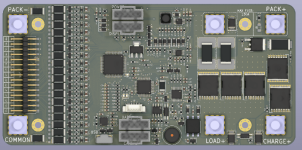I had some time to work on the schematics + PCB part placement today...Design is not finalized, but will be very similar to DieBieMS
ENNOID-BMS-SS (SolidState)
- 70mm x 145mm
- 4 layer board
- 3 main discharge 100V rated FET (Instead of only 2 on DieBieMS) ~120A continuous
- Using the same ENNOID-BMS firmware & software
Features:
- 10 to 18 cells series monitoring + passive balancing 33ohm resistors per channel
- 9 temperatures sensor channels available
- On-board 3.3V power supply taken from the battery pack voltage
- Load + Battery Voltage sensing
- Current sensing
- Integrated predischarge
- Board mounted Fuse on top right (Not shown)
- High side switches (all switches use N-channel FETs on the positive terminal so ground/negative stays connected)
- Charger detection circuit
- Separate charge/discharge circuit
- Charge bypass FET for reducing heating during high current charging
- Bolt on 180A terminals wurth #7461383
I/O: serial(UART/Bluetooth), CAN, USB, I2C(Display), Power button






